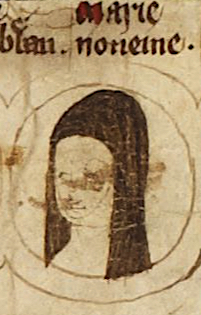Mary of Woodstock
Mary of Woodstock (born March 11 or 12, 1279 in Woodstock Palace , Woodstock ; † around 1332) was an English princess who entered the Benedictine order as a nun .
Mary of Woodstock was a daughter of King Edward I of England and his first wife, Eleanor of Castile . She got her nickname after her place of birth in Oxfordshire . At the insistence of her grandmother Eleanor of Provence and to the annoyance of her mother, she entered Amesbury Priory , Wiltshire , as a nun in 1285 at the age of seven . Her grandmother, the widow of Edward's father Heinrich III. , lived in the monastery, where she died in 1291. As a subsidiary of Fontevrault , the old burial place of the Plantagenets in Poitou , France , Amesbury was held in high regard by the English royal family. Even as a nun, Mary led a life there according to her high rank. She received an annual pension of £ 100 from her father in 1285. The intention that Mary should even go to Fontevrault as a nun was dropped after her grandmother's death, presumably at her father's insistence. Instead, after Eleanor of Provence's death, he doubled Mary's annual pension, and from 1292 onwards she received 40 oaks from the royal woods and 20 barrels of wine from Southampton .
Mary did not accept the secluded monastic life in Amesbury and evidently did not take the rules of the order too seriously. She often returned to the royal court with a large entourage, where she was known for her extravagance. In 1293 she spent a lot of time at the royal court with her younger brother Eduard . In 1297 she stayed at the royal court for five weeks, during which she said goodbye to her sister Elizabeth , who was married to Holland. In 1302, Mary's financial support was changed, instead of the annual pension, she received a number of estates and the borough of Wilton on condition that she remain in England. From these possessions, however, she received less income than she spent, so that by 1305 she had considerable debts. At the time she had a large retinue that required 24 horses to transport, and she increased her debts by playing dice for money. Her father gave her £ 200 to pay off her debts. In 1345, long after her death, John de Warenne, 7th Earl of Surrey , claimed that he had had a sexual relationship with her. He wanted to achieve that his marriage to Mary's niece Joan was annulled, which he did not succeed. There is no evidence of this alleged relationship other than Warenne's testimony.
Her brother Eduard, who succeeded her father as king in 1307, also supported Mary. During his reign, Mary continued to visit the royal court regularly, but she also made frequent pilgrimages. In 1317, her brother asked her to pay a visit to the English daughter monasteries of Fontevrault , which she refused. Although she held a certain rank within the order because of her rank, she never held an official position. At Amesbury she only cared for other, younger nobility nuns.
The English chronicler Nicholas Trevit dedicated his work to her. The exact year of her death is unknown, after her death she was buried in Amesbury.
Web links
- Michael Prestwich: Mary (1278 – c.1332). In: Henry Colin Gray Matthew, Brian Harrison (Eds.): Oxford Dictionary of National Biography , from the earliest times to the year 2000 (ODNB). Oxford University Press, Oxford 2004, ISBN 0-19-861411-X , ( oxforddnb.com license required ), as of 2004
Individual evidence
- ↑ Michael Prestwich: Edward I . Berkeley, University of California Press, 1988, ISBN 0-520-06266-3 , p. 128
| personal data | |
|---|---|
| SURNAME | Mary of Woodstock |
| BRIEF DESCRIPTION | English princess and nun |
| DATE OF BIRTH | March 11, 1279 or March 12, 1279 |
| PLACE OF BIRTH | Woodstock Palace , Woodstock |
| DATE OF DEATH | around 1332 |
